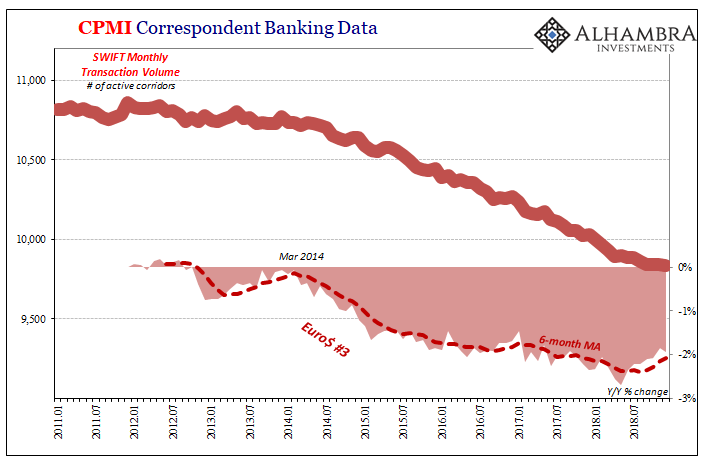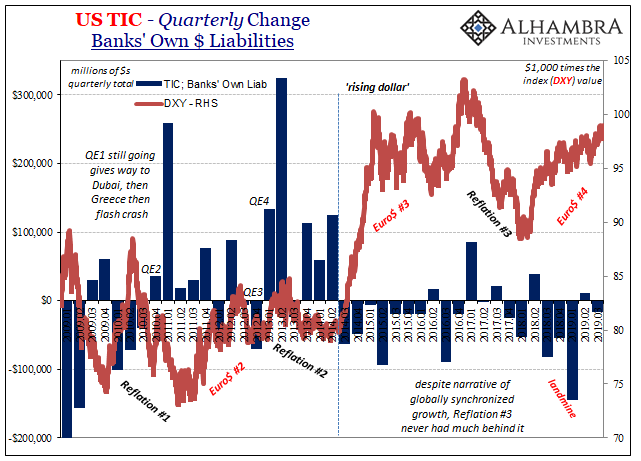One of the biggest reasons why I always find the regulations explanation(s) so lacking is because of what is the biggest part of the scientific process. The excuses for problems in global liquidity and the dollar-based banking system in general have run the gamut of regulatory exercises.
Who can forget, for one example, 2a7? That was 2016’s preferred explanation for a range of imbalances and “anomalies” that showed up at seemingly the most inopportune time. Always “unexpectedly.” The worldwide economy was supposed to have accelerated into full blooming recovery, but it didn’t and more so it didn’t whilst the dollar system was embroiled in very obvious malfunctions somehow no one saw coming.
But, and I wrote at the time I would quit Alhambra and join a monastery, it would’ve been at least somewhat convincing had anyone who understood 2a7 (including the officials who pushed for it) to have said – in advance – the new requirements might cause substantial liquidity problems. Instead, what happened, what always happens, is that the liquidity problems arose and then the regulatory defense is applied retroactively.
That’s not science. It’s flavor of the month.
Science is making predictions based on sound theories and having them stand up to the test of time. A testable prediction is rather something like this:
What all this data shows, as opposed to conjecture about the supernatural powers of central banks, is that yuan’s devaluation may be directly tied to dollar shortages. In fact, as I argue here, it is far more plausible that a dollar shortage (showing up as a rising dollar, or depreciating yuan) is forcing the PBOC to allow a wider band in order that Chinese banks can more “aggressively” obtain dollars they desperately need. Worse than that, the PBOC itself cannot meet that need with its own “reserve” actions without further upsetting the entire fragile system.
I wrote that on March 19, 2014, which has turned out to have been an enormously important point in monetary history – for China as well as everywhere else. Not only did the dollar rise, and then rise some more, as it has turned out everything was permanently changed by it. The evidence keeps piling up more than half a decade later.
In fact, all 2a7 actually accomplished was to briefly capture some mainstream attention in response to that very thing.
And then everyone went back to sleep in 2017, comforted by the reassurances of globally synchronized growth, only to be rudely woken back up in 2018 as the dollar again rose and synchronized growth was so easily replaced with a synchronized downturn.
Then repo.
A market hardly anyone paid much attention to was thrust into the spotlight. Because it was, suddenly in the aftermath there is an academic rush to explain why. As before, as far back as 2007, no one said anything beforehand. But once it happened, the need for a benign (sounding) explanation is paramount.
To make these connections, the new flavor of the month is G-SIB. In large part because of Zoltan Pozsar, these things have been conveniently connected (but still haven’t added up to Zoltan’s unwavering conclusion that interest rates have nowhere to go but up). Like 2a7, it sounds so technically correct (how would anyone know?) and so just enough to be plausible.
The G-SIB argument features quarter-end window dressing, a healthy dose of FX derivatives, and the generalized illiquidity that “somehow” pushed a flat-footed, unscientific Fed into not-QE T-bill buying along with a repo relationship it today apparently doesn’t know how to escape. Seems to cover all the visible bases.
The abbreviation G-SIB stands for global systemically important bank. The designation is not merely statutory academics; this is not an arbitrary label. Being classified as one creates several regulatory hurdles and impositions that can have a real effect on anyone’s banking operations. That’s the kernel of truth at its root.
You can read about it here, including how they were supposed to have been related to repo (and Zoltan).
There is more academic study and research showing the same links. Another one was published by the BIS (my thanks to Mark S.) just a few days ago. The evidence it presents fits right in line with what I’ve been showing recently, about the retreat of dollar-based global banking since 2014.
Less banks, rising dollar, no economic growth. That’s the theory I laid out in advance.
That’s not really what the study’s authors interpret, however, given their singular focus on finding a relationship between obvious liquidity problems and how it has to be G-SIB related. Their synopsis of the findings:
First, bid-ask spreads in spot and FX swaps are highly correlated. Second, deterioration in FX funding liquidity, as measured by forward discount or CIP deviations, is associated with a widening of bid-ask spreads in spot FX. Third, this link between FX funding and market liquidity conditions has strengthened significantly since mid-2014. Fourth, the partial shift of intermediation in FX swaps toward smaller dealers as the desks of G-SIBs periodically pull back is behind much of the liquidity dynamics described.
You can (and should) read the whole thing; there is a lot of interesting detail that explores the relatively unexplored world of FX swaps-as-money and how it is linked to liquidity (in what they call the “spot market”). To me, there is functionally no difference between a currency swap and short-term dollar lending; there certainly isn’t to market participants on the borrowing side (though there is a huge preference for lenders toward swaps, as this one paper does briefly acknowledge).
In lieu of toiling through 61 pages of highly technical jargon, possibly indecipherable charts, and a seemingly endless series of tables spilling out specific regression calculations, what follows is my own summary of the paper’s work.
Liquidity is and has been a problem in the FX market, a source of “contagion” into the spot market, all going back to around…2014. To figure out why, meaning how they can blame G-SIB, the authors study bid-ask quotations including the frequency of them among three different classes of bank dealers. The idea was to see if there were any statistically significant variances in that behavior which might point to specifically G-SIB banks and then argue for regulations as the cause.
And there were.

What they found was a significant correlation between large dealers pulling back FX activities (fewer instances of offering quotations) and smaller dealers entering the market at wider spreads. But since smaller dealers aren’t sophisticated enough or offer sufficient scale, they don’t provide sufficient liquidity to close the gaps.
Therefore, whenever we see smaller dealers show up in FX markets, it’s a pretty solid signal that it’s going to be problematic (illiquid) and it’s because the larger dealers are taking a step back.
While large dealers still dominate market-making in spot markets at all times, and their quoting intensity is associated with improved liquidity dynamics, they have exhibited a tendency to pull back from posting price quotes in FX swaps around balance sheet reporting periods. Yet, as large dealers are displaced by smaller, and as such more expensive and less informed, dealers in the swap markets, spot market liquidity appears to also suffer because liquidity conditions in spot and swap markets are tightly linked.
Furthermore, the authors find this effect most pronounced around quarter-ends and among the class of banks identified near exclusively as G-SIBs. Indeed, you can see it on the chart above that I’ve taken from the paper, these quarter-end periods highlighted by its authors. The effects around those times are obviously pronounced, matching our recent real-world experience.
But it also misses, I believe, the wider issue. While there is a more obvious skew at and around quarter-endings, more subtly is the baseline change in direction around which those take place. In other words, all the signals that point to FX therefore spot illiquidity have been leaning in those directions more and more since 2014.
The liquidity problem overall has been there underneath yet only noticed when it becomes more pronounced at particular calendar chokepoints. The paper takes note of only those while not offering any explanation for the very different more constant background behind them.
Sure, you can see a lot of noise and fury at those shaded portions, but what about the different trend direction each line has taken the rest of the time?
Rather than being specifically a G-SIB issue for quarter- and year-end, maybe those things have become a problem because “something” changed in terms of large dealer-based functioning (risk/return balance sheet considerations) half a decade ago. They are saying it is G-SIB designations that create the more pronounced quarter ends, but maybe the real problem is how banks that just so happen to be systemically important and those nearest to them are cutting back more imperceptibly (and steadily) at not just quarter-ends.
Like I said before, it would’ve been far more convincing had an official, any official warned in 2014, hey, everyone should watch out for how this G-SIB thing could cause some problems especially at quarter-ends. Instead, they wait until monetary problems show up (after maintaining for months on end there was no problem) and then go back and see how they might define them under only the terms they know – the same framework of understanding that caused the official class of experts to be caught completely off-guard in the first place.
G-SIB is the new 2a7; the underlying banking therefore “dollar” problem is neither new nor really G-SIB.


What I see instead is yet more evidence for what I wrote back then. The “dollar” is banking (especially at the top) and as we continue to find and document consistently less of the latter therefore fewer of the former. A private monetary system slowly decaying if in the background.
In other words, the big guys had created the “dollars” (as well as other currencies) that the whole vast network(s) would transmit back and forth as needed in a globalizing economy. Since 2011, and really 2014, the bigger players have taken a step back in monetary creation (as we know from other sources like TIC) as well as payments processing.
Not only less payments processing (correspondent banking) to go along with fewer “dollars” since 2014, fewer FX quotes among the big guys, too, also dating back to…2014.
The problem, as I said yesterday for the nth time, isn’t actually the dollar it is how the modern monetary system of eurodollars depends upon banks (credit-based) for sufficient functioning as a global reserve currency. All the evidence keeps saying that there is less of banking capacities for inherent structural reasons (risk/return) and that the regulatory excuses only line up in specific, narrow cases.
If you don’t factor the trends hidden underneath you are easily dazzled by the spectacle of those more dramatic instances that break above the surface. It really is a tip-of-the-iceberg situation. Where Economists are paid to notice and interpret only what pokes out above the waves.
Even though the underlying issue continues unresolved, the mainstream justifications for them never, ever come out ahead of time. They do change as the years go by, though. Entertaining, yes. Informative, not quite (though, to be fair, I thought this one paper was quite illuminating if only for exploring several narrower, more technical facets of the problem).
And that’s why Euro$ #4 will at some point inevitably transition into only Reflation #4 rather than any chance at Recovery #1.

Stay In Touch